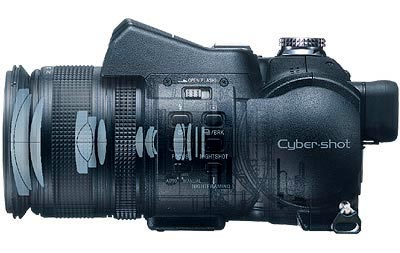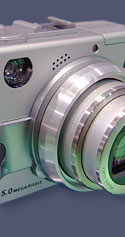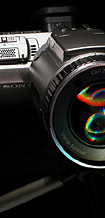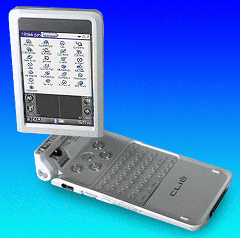|
Here Comes the
828! (Winter 2003)


8 megapixels
5:1
Zoom
28mm
to 200mm equivalent (and marked that way!)
Holo
Night Focus Projector
Manual
Zoom Ring--direct link--YAY!
Hotshoe
NightShot
Now
- Black
- Sharp
- EVF
- Zeiss lens
- $999
- FASTFASTFAST

Here Comes V1!
(May 2003)

 5 megapixels 5 megapixels
4:1
Zoom
Holo
Night Focus Projector
Small
Hotshoe
NightShot
Soon
- Beautiful
- Sharp
- Optical Viewfinder
- Zeiss lens
- $700
- Special Converter
Optics

707 Becomes 717!

 In October, 2002, Sony will introduce
the DSC-F717, an upgrade to the famed DSC-F707. It's virtually
the same camera with a list of very attractive improvements. In October, 2002, Sony will introduce
the DSC-F717, an upgrade to the famed DSC-F707. It's virtually
the same camera with a list of very attractive improvements.
- Higher ISO
sensitivity of 800
- Novice auto
mode
- HQX Movie
mode that shoots as long as you have memory space
- Zoom demand
via the front "focus" ring
- Faster start
up time
- Intelligent
hot shoe for external flash
- 5-zone, 6-way
focus acquisition areas
...and a number
of minor improvements to the menu Set Up system. All other great
features of the 707 have been retained.
It's not a
huge set of improvements, but this is not a camera that needs
huge improvements. The Sony F7x7 cameras are rapidly becoming
the definition of digital photography's state of the art and
the 717 is an example of the sort of careful upgrade we've seen
previously in cameras like the Leica M series in 35mm film.
The big news
around here is that the Sony eBook will feature BOTH the DSC-F707
and DSC-F717 from its debut on September 15. Weeks before you
can buy the 717, you can explore its secrets in the Sony eBook.

EXTREME PDA! updated 9 22 2002

 In March, 2002, Sony
announced the imminent arrival of two new PDAs in their Clie
line. The PEG-NR70 and PEG-NR70V. In March, 2002, Sony
announced the imminent arrival of two new PDAs in their Clie
line. The PEG-NR70 and PEG-NR70V.
That last
one got our attention right away. It has a built-in digital camera
hiding within its hinge.
The format
of each is identical, except for the camera. That adds a hundred-dollar
premium to the price. It doesn't make a high resolution image,
in fact it is just a bit larger than a QVGA frame, but, hey,
when you need to take a shot--it didn't weigh anything or take
up more room in your pocket or purse--so why not?
I've been
using one of these since May, 2002 and it has become an indispensible
part of my work pattern. Like all PDA's, it keeps me on schedule
and takes notes whenever I wish. It is a finger-actuated calclulator,
an MP3 player, an emergency camera and a reliable list-keeper.
Friends ask
me about it a lot. One, who heads a local high tech animation
company, keeps movies on his that show his work. A pocket video
player! Too bad the built-in camera isn't into shooting movies!
The image
screen is a jaw dropper. You may remember how great-looking the
color screen looks on their previous model PDA, the PEG-T615C
(Who, I demand to know, dreams up these names?) with its "transflective"
viewing. Meaning, it works in just about any light situation
whether rear-lit or under bright light.
Well, the
new ones have the same screen, only bigger. Now the screen area
is 320 x 480 pixels large and completely fills one whole side
of the device. But the device has four sides. How? That clamshell
design allows it to have two protective surfaces in addition
to its screen and control surfaces.
Sony has put
all this to good use. As you may interpret from the picture,
you can fold it flat with everything protected, or open it to
make a cell-phone-like larger unit, or you can flip the screen
and fold it flat making a normal-looking PDA configuration. No,
it does not have a cell phone inside, but they're working on
it. At least they SHOULD do that. A wireless PDA/cell phone this
size will exist in the future, but this isn't that, yet.
Flat, it is
a bit larger than the smallest PDA's but look what is lurking
under the hood:
- It is a Palm
OS™ PDA so it takes all that available software.
- It is a Wireless
Remote Control for many IR devices--even non-Sony!
- It has the tiny
camera for shots anywhere, anytime.
- Its color screen
has 153600 pixels and is quite bright.
- It will display
images from your Memory-Stick digital camera.
- It is a fully
functioning MP3 player (comes with remote & earphones).
- It enters your
computer from its USB cradle (included).
- It expands with
Memory Stick media.
- It has a miniature
QWERTY keyboard on one surface.
- It beeps appointment
reminders at you from a built-in speaker.
Availability
is now.
About $600
for the one with the camera and $500 for a version without the
camera.
Comments:
For whatever
reason, Sony does not efficiently compress the images the on-board
camera shoots. They each take up 156,000 bytes of memory! The
image quality is Not Great. Each image can be effectively compressed
to about 8K in Photoshop, but they take up nearly twenty times
that much space in the memory-starved Clie.
Can somebody
at Sony's Clie design team please 'splain that to me? I hope
they find a way to upgrade the camera system via firmware.
Here's a Sony
Link
that tells you the official word.

World's Smallest
Video Studio!! updated 9 22 02 
 Okay,
that's overstating the idea, but this is the world's smallest
broadcast quality video camcorder. Of course, the idea of what
qualifies for the title "broadcast quality" may be
a pivotal argument in that last sentence, but when you have actually
been involved in broadcasting images from something this small,
you may change your mind. Okay,
that's overstating the idea, but this is the world's smallest
broadcast quality video camcorder. Of course, the idea of what
qualifies for the title "broadcast quality" may be
a pivotal argument in that last sentence, but when you have actually
been involved in broadcasting images from something this small,
you may change your mind.
Let's put
it this way, the Sony DCR-IP7BT (and slightly less capable DCR-IP5)
make video images in MPEG2 format that are 500 video lines horizontally
versus broadcast video's 330 lines horizontal. Is that good enough
to be "broadcast quality" or do we need to define a
different buzzword here? How about this: It's virtually the same
image quality as DV video, which has been arriving on your TV
from all over the world in the last few years. Ever watch "Survivor?"
Anyhow, these
are the first two camcorders in the new MICRO-MV format which
uses a tape cassette 70% smaller than a MINI-DV cassette. Yow!
The camcorder only weighs 12 ounces. And they both have a 10:1
Carl Zeiss Vario Sonnar™ zoom lens punching images into
a Sony 680,000 pixel image sensor.
Like all of
the DV cameras, there is a digital zoom thing included for those
of you who like silly extremes. In this case you can zoom into
Bigfoot with a 120X zoom, but geez, that isn't a great looking
effect at all. Never mind, there are the gang of usual amaterurish
"special effects" that have been with us since the
days of Hi-8 available in the menus. Want Sepia, Posterization,
Mosaic, Negative and more? Show of hands? Anybody? The good thing
is, you are not required to use digital zoom and/or special effects
at all.
The DCR-IP7BT
model has built-in Bluetooth transmission. With the right peripheral,
the included BTA-NW1 Modem Adaptor, you can Bluetooth onto the
web and browse on the camcorder screen. 30 feet (10 meters) is
all it covers, but wireless is the future, and it's a start.
That same
model is the only one that takes Memory Sticks for capturing
VGA still images. Now you can combine your Sony PDA (above) and
review shots on either device.
Like its DV
older siblings, the DCR-IP -series have an iLink output (A.K.A.
Firewire) for input to your computer and the units come with
a software program for basic in-computer editing.
A significant
point to the MPEG2 image format is this: The image is very good
looking but takes up less than half of the storage space of DV
images. Meaning, your computer can hold over twice as much video.
No pain there.
The viewfinding
is via the flip-out screen or eyepiece finder. I picked
one of these up at PMA and mistook the eyepiece image for an
optical viewfinder--as if it were a direct view through the glass
of the lens--it's that good.
Worth noting:
- Super SteadyShot--Sony's
very effective way of stabilizing the image by indexing to a
subset of the 680K pixels. In practice, it makes uncompromised
full-resolution images that are MUCH more stable.
- Progressive
shutter for still images (no interlace artifacts).
- Scene thumbnails
that let you locate scenes visually from the tape. The memory
for these is in the cassette.
- Memory Stick
recording of stills on the -BT model. But you can record them
on the tape, too, with either camera.
- 16:9 mode
for wide screen TV owners.
Both camcorders
are available today. About $1700 and $1300.
Hands ON Report:
Well, it certainly
is small. That's good when space is at a premium, such as for
vacation or keeping it with you all the time. The image quality
is quite good. Colors are accurate, audio is nice and it makes
an image that is very artifact-free.
But the tiny
stud that serves as a zoom control is among the worst ever produced.
It has no "feel." The control is proportional making
the zoom move from slow to quick, but without any feedback or
tactile feeling from the single button, you can't intuitively
use it. Darn. This alone would send me on to other products.
Sony's own small DV cameras, for instance.
In-camera
stop/starts produce an unwanted effect on playback. At each stop/start
point, the image freezes for about half a second, disrupting
the sense of flow in a major way. Darn, again.
Much of the
optional functions that are buried in this camcorder can only
be accessed via the many faceted menu system. Puzzling your way
through it is a painful, counter-intuitive process. Darn three
times. And you are out.
Sorry, Sony.
This one promised much, but didn't make the grade.
Want more?
Visit the Sony
site.
Perhaps Sony's
newest, swing down pistol grip MicroMV camcorder is better. Check
out the DCR-IP55 here.

|